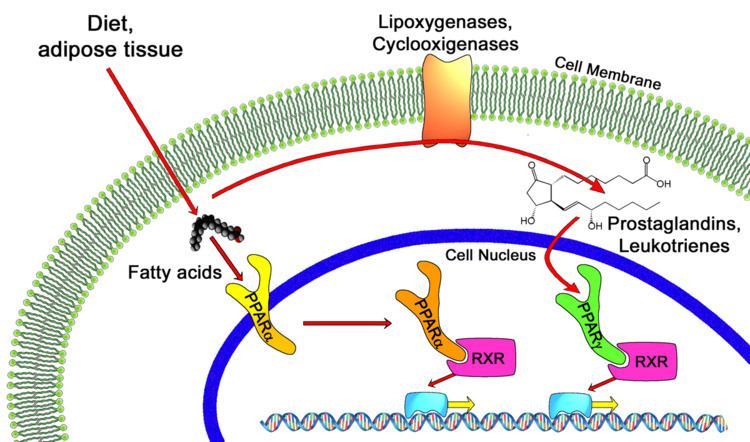 | ||
PPAR agonists are drugs which act upon the peroxisome proliferator-activated receptor. They are used for the treatment of symptoms of the metabolic syndrome, mainly for lowering triglycerides and blood sugar.
Contents
Classification
PPAR-alpha and PPAR-gamma are the molecular targets of a number of marketed drugs. The main classes of PPAR agonists are:
PPAR-alpha agonists
PPARα (alpha) is the main target of fibrate drugs, a class of amphipathic carboxylic acids (clofibrate, gemfibrozil, ciprofibrate, bezafibrate, and fenofibrate). They were originally indicated for cholesterol disorders and more recently for disorders that feature high triglycerides.
PPAR-gamma agonists
PPARγ (gamma) is the main target of the drug class of thiazolidinediones (TZDs), used in diabetes mellitus and other diseases that feature insulin resistance. It is also mildly activated by certain NSAIDs (such as ibuprofen) and indoles, as well as from a number of natural compounds. Known inhibitors include the experimental agent GW-9662.
They are also used in treating hyperlipidaemia in atherosclerosis. Here they act by increasing the expression of ABCA1, which transports extra-hepatic cholesterol into HDL. Increased uptake and excretion from the liver therefore follows.
Animal studies have shown their possible role in amelioration of pulmonary inflammation, especially in asthma.
PPAR-delta agonists
PPARδ (delta) is the main target of a research chemical named GW501516. It has been shown that agonism of PPARδ changes the body's fuel preference from glucose to lipids.
Dual and pan PPAR agonists
A fourth class of dual PPAR agonists, so-called glitazars, which bind to both the α and γ PPAR isoforms, are currently under active investigation for treatment of a larger subset of the symptoms of the metabolic syndrome. These include the experimental compounds aleglitazar, muraglitazar and tesaglitazar. In June 2013, saroglitazar was the first glitazar to be approved for clinical use.
In addition, there is continuing research and development of new dual α/δ and γ/δ PPAR agonists for additional therapeutic indications, as well as "pan" agonists acting on all three isoforms.
